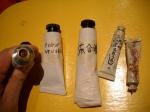Urushi Adventures
Urushi Adventures
I just got some urushi from a woodwind instrument maker.
That urushi was lying around his stuff for many years unused, so he let me take some.
I filled few metal tubes and tried to copy the labels of the originals and also got few smaller tubes with stuff he said is urushi sabstitude but since i know cashew urushi already i know the tube looks diffrent.
I started working with what i think is roiro urushi which is very black and thick, trying to make some loose flute joint snug again,
its preety dry after 2 days in a humid box but got some stuff that looks like dust particles in it and also few wrinkles although i tried to paint in the thinnest layer i could.
This lacquer is beautiful! i also think im lucky to be not allergic to it since i touched it few times, washed my hands and nothing happen.
I got so many questions but no one to ask them and also couldnt find the answer anywhere on the net.
what is written on the labels?(-see pictures)
how can i filter the urushi other then the traditional paper method?
should i filter it at all?
should i always use shuai urushi (that brown translucent one) as a primer before the others?
How can i polish it/sand it/etc?
how long does it take to dry before you can sand it/ put the joint together?
and also specifically how can you know if you got a fit when you work on a flute joint? because the flute swells moisture and the joint is tighter then it is normally.
Any info would be appreciated.
Thanks!!


That urushi was lying around his stuff for many years unused, so he let me take some.
I filled few metal tubes and tried to copy the labels of the originals and also got few smaller tubes with stuff he said is urushi sabstitude but since i know cashew urushi already i know the tube looks diffrent.
I started working with what i think is roiro urushi which is very black and thick, trying to make some loose flute joint snug again,
its preety dry after 2 days in a humid box but got some stuff that looks like dust particles in it and also few wrinkles although i tried to paint in the thinnest layer i could.
This lacquer is beautiful! i also think im lucky to be not allergic to it since i touched it few times, washed my hands and nothing happen.
I got so many questions but no one to ask them and also couldnt find the answer anywhere on the net.
what is written on the labels?(-see pictures)
how can i filter the urushi other then the traditional paper method?
should i filter it at all?
should i always use shuai urushi (that brown translucent one) as a primer before the others?
How can i polish it/sand it/etc?
how long does it take to dry before you can sand it/ put the joint together?
and also specifically how can you know if you got a fit when you work on a flute joint? because the flute swells moisture and the joint is tighter then it is normally.
Any info would be appreciated.
Thanks!!


Last edited by Itamar Foguel on 2011-05-14, 12:23; edited 1 time in total
update: i think the roiro is the glossy type, it dries glossy but with tiny particles,
the second one is Shuai urushi, dries dark brown. and the third opened tube i have no idea.
i did 2 lyers of roiro urushi, first one had to be sanded because it was buckled and unclean, second one was thinned with a bit of turpentine, some of it got glossy finish and some of it matte finish...its weird
any tips about polishing urushi?
oh and here is a link to a nice Urushi Glassory:
http://www.hakuminurushi.com/urushi/glossary.html
the second one is Shuai urushi, dries dark brown. and the third opened tube i have no idea.
i did 2 lyers of roiro urushi, first one had to be sanded because it was buckled and unclean, second one was thinned with a bit of turpentine, some of it got glossy finish and some of it matte finish...its weird
any tips about polishing urushi?
oh and here is a link to a nice Urushi Glassory:
http://www.hakuminurushi.com/urushi/glossary.html
Répondre
